Epson EMP-1715, EMP-1705 User Manual
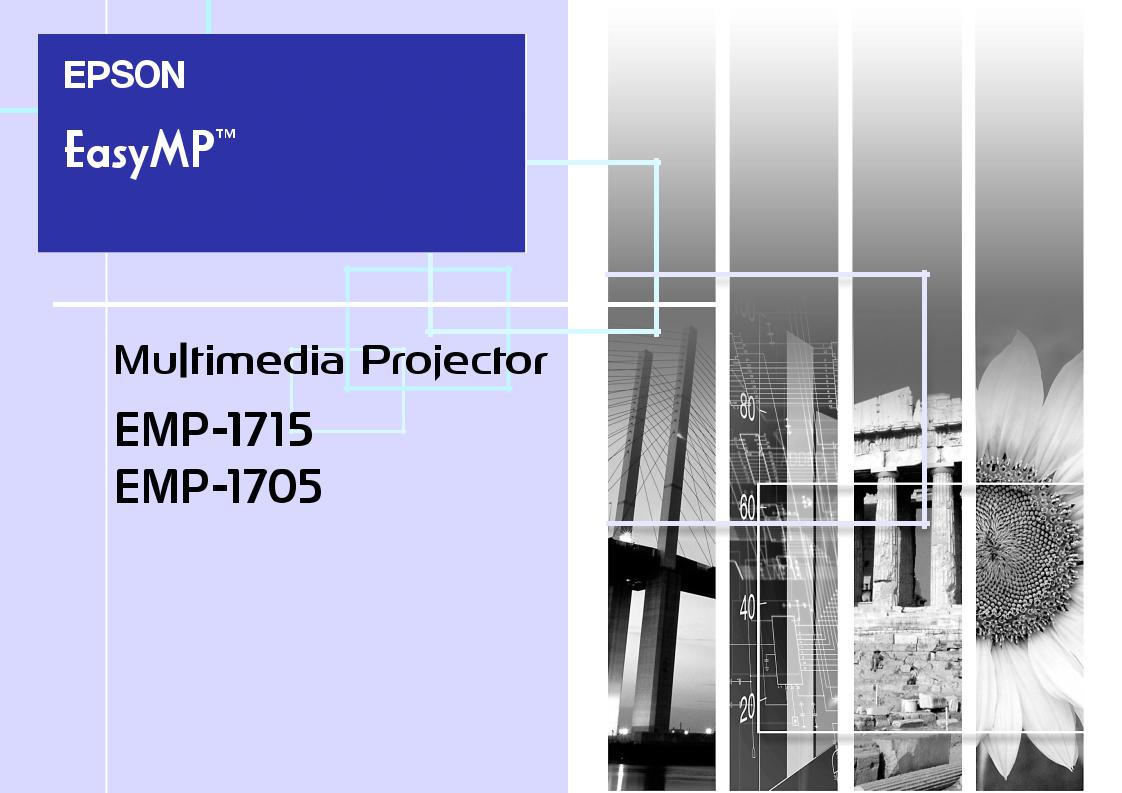
1
Operation Guide |

Contents |
2 |
|
|
Overview of EMP NS Connection |
|
Two connection modes.............................................................................. |
5 |
Quick Connection Mode....................................................................................... |
5 |
Advanced Connection Mode ................................................................................ |
5 |
Steps up to the making of an EMP NS connection ................................. |
6 |
Using the main screen of EMP NS Connection ....................................... |
7 |
Wireless LAN Security Countermeasures................................................ |
9 |
Using the Toolbar ..................................................................................... |
10 |
Icon Names and Functions ................................................................................ |
10 |
Convenient EMP NS Connection Functions |
|
Projecting Only a PowerPoint Slideshow (Presentation Mode)........... |
13 |
Projecting Movies from a Computer (Movie Sending Mode)................ |
14 |
Supported file types ........................................................................................... |
14 |
Playing back a movie ......................................................................................... |
14 |
Using Multi-Screen Display ..................................................................... |
16 |
Example of Adjusting the Virtual Display ........................................................... |
16 |
Procedure before using the Multi-screen Display Function................................ |
17 |
Setting the Virtual Display .................................................................................. |
18 |
Allocating the image to be projected .................................................................. |
23 |
The allocated image is projected ....................................................................... |
23 |
Connecting to a projector on a different sub-net |
|
Connecting to a projector on a different sub-net .................................. |
26 |
Searching by Specifying the IP Address and Projector Name |
|
(For "Advanced Connection Mode" only) .............................................. |
27 |
Performing a search with a profile.......................................................... |
28 |
Making a Profile ................................................................................................. |
28 |
Searching by Specifying a Profile ...................................................................... |
30 |
Managing a Profile ............................................................................................. |
31 |
Setting the EMP NS Connection Operation |
|
Setting the EMP NS Connection Environment ...................................... |
34 |
General settings Tab.......................................................................................... |
34 |
Adjust Performance Tab .................................................................................... |
36 |
Using a Computer to Set Up, Monitor and Control |
|
Projectors |
|
Changing Settings Using a Web Browser (Web Control)..................... |
38 |
Displaying Web Control ..................................................................................... |
38 |
Projector Setup .................................................................................................. |
38 |
Using the Mail Notification Function to Report Problems ................... |
39 |
Setting Mail Notification Function ...................................................................... |
39 |
If a Problem Notification is Sent by Mail ............................................................ |
39 |
Management Using SNMP....................................................................... |
40 |
Presentations Using PC Free |
|
Files that can be Projected Using PC Free, and Saving....................... |
42 |
Files that can be Projected Using PC Free........................................................ |
42 |
PC Free Examples............................................................................................. |
43 |
PC Free Basic Operations ....................................................................... |
44 |
Starting and Closing PC Free ............................................................................ |
44 |
Guide Mode and Quick Mode ............................................................................ |
47 |
PC Free Basic Operations ................................................................................. |
48 |
Rotating the Image ............................................................................................ |
49 |
Projecting Scenarios ............................................................................... |
50 |
Preparing a Scenario ......................................................................................... |
50 |
Playing a Scenario............................................................................................. |
50 |
Operating During a Presentation ....................................................................... |
51 |
Projecting image and movie files ........................................................... |
52 |
Projecting Images/Movies................................................................................. |
52 |
Projecting all Image and Movie Files in a Folder in Sequence (Slideshow) ...... |
53 |
Setting Image and Movie File Display Conditions and Operation |
|
Mode.......................................................................................................... |
55 |

Contents |
3 |
Preparing a Scenario (Using EMP SlideMaker2) |
|
Scenario Summary ................................................................................... |
57 |
Files that Can be Included in Scenarios................................................. |
58 |
Turning a PowerPoint File into a Scenario ............................................ |
59 |
Converting all files in a single operation without starting up |
|
SlideMaker2............................................................................................... |
60 |
Starting up SlideMaker2 and converting files........................................ |
62 |
Setting Scenario Properties ............................................................................... |
62 |
Including PowerPoint Files in Scenarios ............................................................ |
64 |
Including Image and Movie Files in Scenarios................................................... |
67 |
Editing a Scenario.............................................................................................. |
68 |
Sending Scenarios ................................................................................... |
70 |
Cases Like These ..................................................................................... |
72 |
Checking the Projection Scenario Status from a Computer............................... |
72 |
Setting Animations ............................................................................................. |
73 |
Setting the Slide Animation................................................................................ |
73 |
Appendix |
|
Connection Limitations............................................................................ |
76 |
Supported Resolutions....................................................................................... |
76 |
Display Color...................................................................................................... |
76 |
Number of Connecting ....................................................................................... |
76 |
Others ................................................................................................................ |
76 |
Troubleshooting ....................................................................................... |
77 |
Glossary .................................................................................................... |
85 |

Overview of EMP NS Connection
This chapter provides an overview of EMP NS Connection.
Two connection modes........................................ |
5 |
|
• |
Quick Connection Mode..................................................... |
5 |
• |
Advanced Connection Mode .............................................. |
5 |
Steps up to the making of |
|
|
an EMP NS connection......................................... |
6 |
|
Using the main screen of |
|
|
EMP NS Connection ............................................. |
7 |
|
Wireless LAN Security Countermeasures.......... |
9 |
|
Using the Toolbar ............................................... |
10 |
|
• Icon Names and Functions ............................................... |
10 |
|
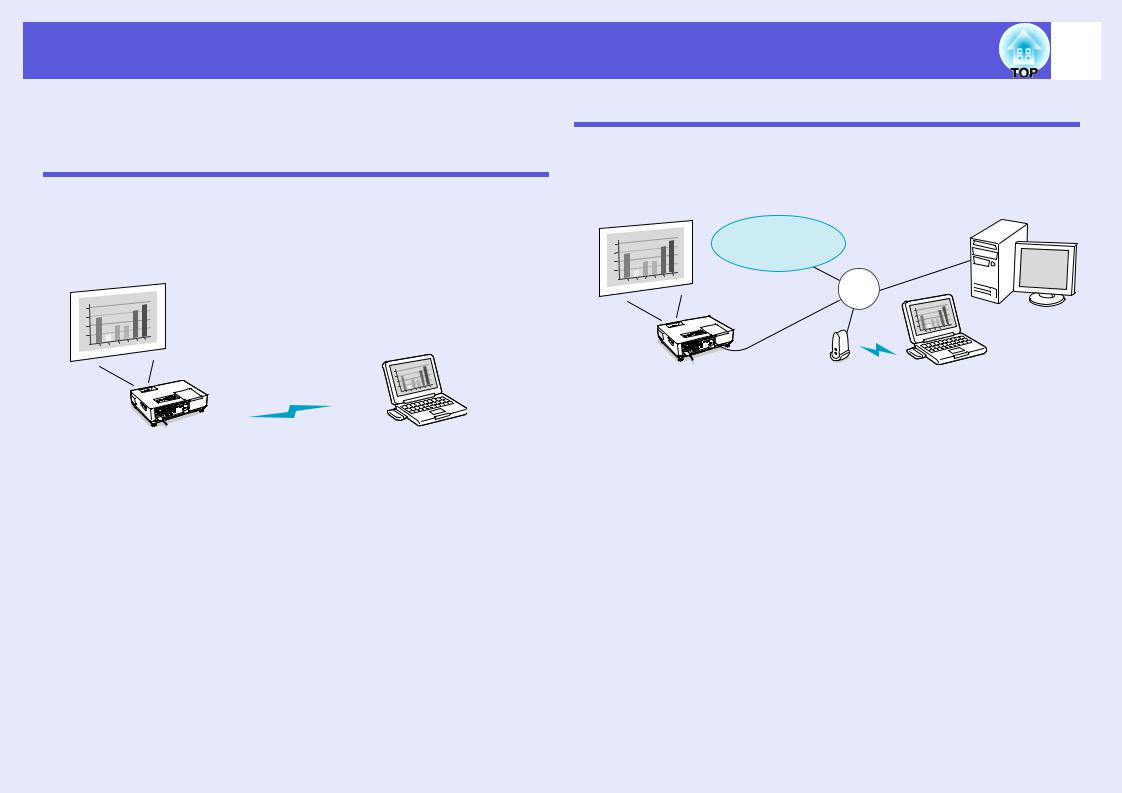
Two connection modes
EMP NS Connection supports two connection modes, namely, "Quick
Connection Mode" and "Advanced Connection Mode".
Quick Connection Mode
•With an ad hoc connection, because the projector’s SSID is temporarily assigned to the computer, you do not have to perform any setup operations from the computer.
•After the computer has been cut off, its network settings automatically return to their original state.
5
Advanced Connection Mode
•With an infrastructure connection, the connection is made to an existing network system.
•This type of connection is used when you want to open and project the contents of a file over a network, share the projector, or apply security.
Internet
LAN
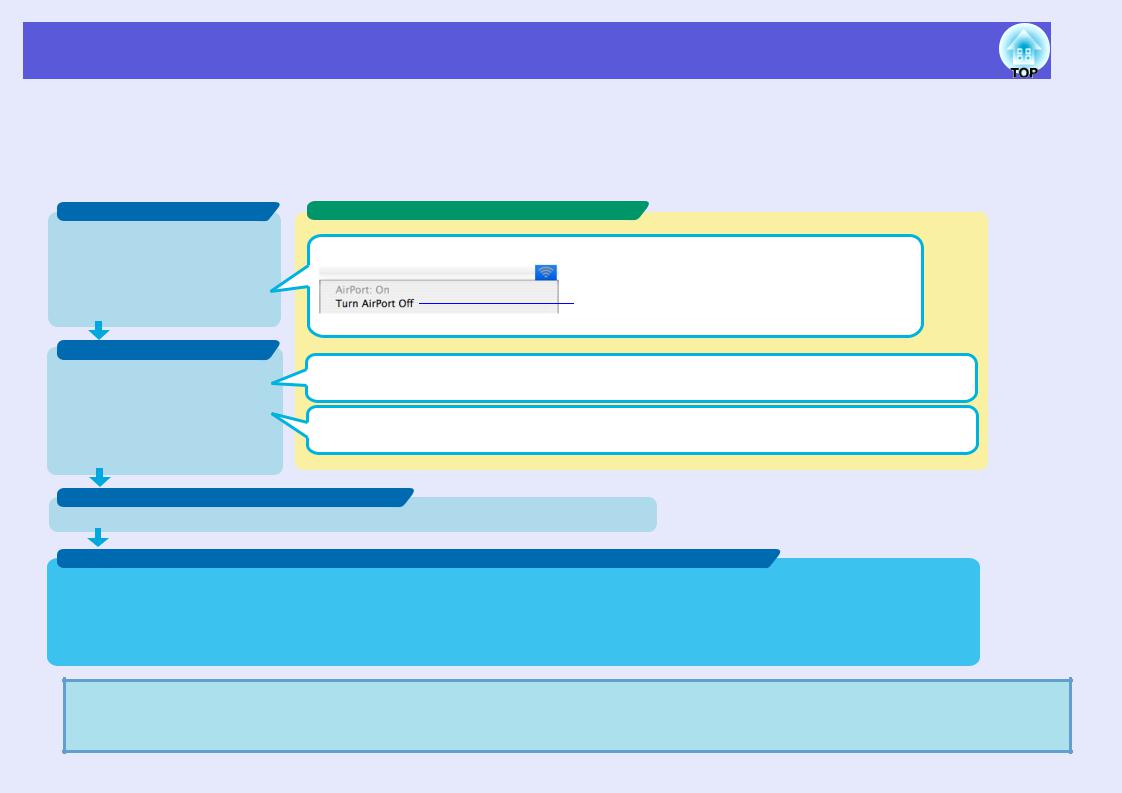
Steps up to the making of an EMP NS connection |
6 |
|
|
The steps leading up to the creation of an EMP NS connection between the computer and the projector are the same in both "Quick Connection
Mode" and "Advanced Connection Mode".
For details on the procedure, see the example of setting up a connection in "Quick Connection Mode" in the Wireless LAN Quick Connection
Guide, provided separately.
This explains the steps to be taken to establish a connection, while also covering the settings to be made in "Advanced Connection Mode".
Preparing the Computer
•Install EMP NS Connection on the computer to be connected.
•Enable the setup of a network connection.
Preparing the Projector
The projector incorporates the same wireless LAN unit.
Advanced Connection Mode Settings
When using a wired LAN with a Macintosh computer, set "AirPort Off" in the communication state.
AirPort Off
Connection is not possible with the wireless LAN
•When using a wired LAN to establish the network connection, install the optional Ethernet unit to the projector and connect the projector using the likes of a commercially available network cable and hub.
• Make the network settings for the projector. sUser's Guide "Network Menu (EMP-1715/1705 Only)"
Establish connection and start projection
Start EMP NS Connection on the computer and then establish a connection with the projector.
The following convenient functions are provided to help users with meetings and presentations
•Multi-Screen Display s p.16
•Movie Sending Mode s p.14
•Presentation Modes p.13
•Distribution function
The screen being displayed by a remote computer can be simultaneously displayed by up to four projectors with corresponding SSID.
•Switching function
With the meeting switching function and assuming that EMP NS Connection has been installed on all the computers, the participants can take turns and project their own images, without the need to swap cables.
qFor details on the restrictions imposed on the projection of computer images over a connection with EMP NS Connection, such as the compatible resolution and display colors, see "Connection Limitations".s p.76
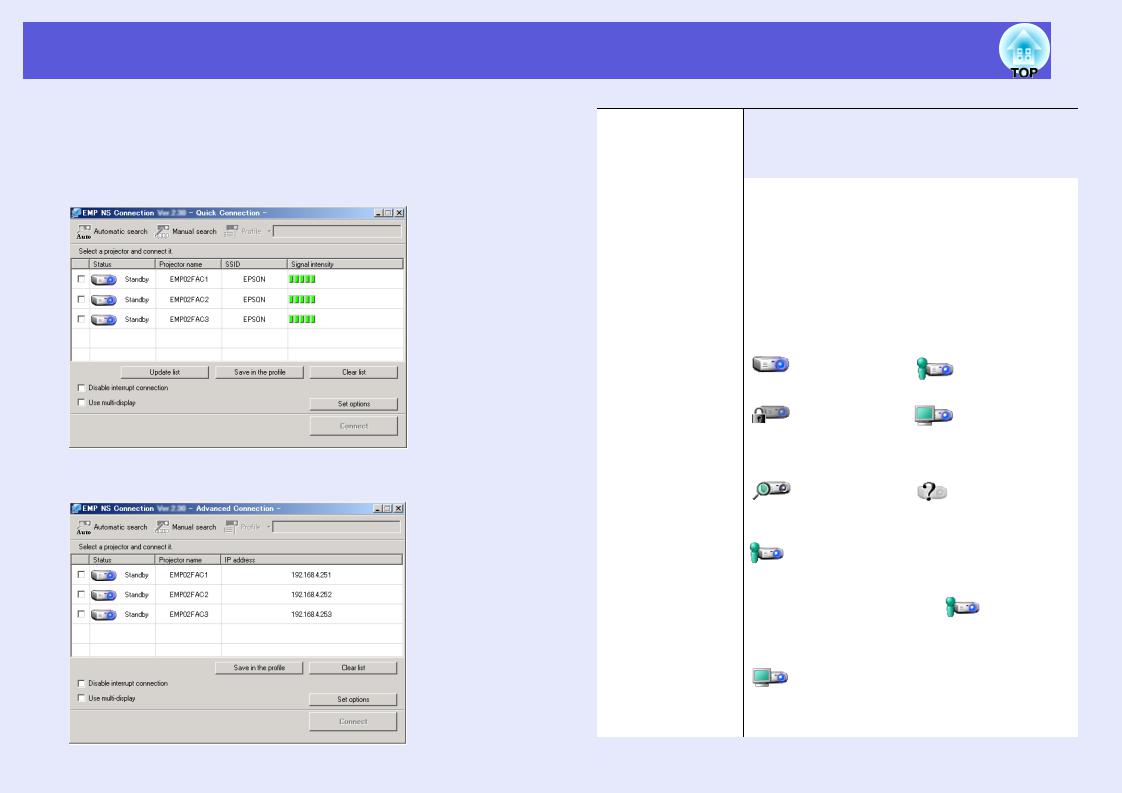
Using the main screen of EMP NS Connection |
7 |
|
|
When EMP NS Connection is started, the following screen is displayed. The operation of each button or menu item is described in the following table.
When the system has been started in "Quick Connection Mode".
When the system has been started in "Advanced Connection Mode".
Automatic search |
In "Quick Connection Mode", a search is made for a |
|||||||||
|
projector based on the SSID. In "Advanced Connection |
|||||||||
|
Mode", you can search for available projectors on the |
|||||||||
|
network system that the computer is connected to. |
|||||||||
|
|
|
|
|
|
|
|
|
|
|
Manual search |
In "Quick Connection Mode", a search is made for the |
|||||||||
|
projector having the SSID selected from a list. In |
|||||||||
|
"Advanced Connection Mode", you can search for a |
|||||||||
|
projector based on a specified IP address or projector |
|||||||||
|
name. |
|
||||||||
|
|
|
|
|
|
|
|
|
|
|
Profile |
You can search for a projector on the network using a |
|||||||||
|
profile saved with "Save profile".s p.28 |
|||||||||
|
|
|
|
|
|
|
|
|
|
|
Status |
The state of an identified projector is indicated using |
|||||||||
|
one of the following six icons. |
|
||||||||
|
|
|
|
Standby |
|
|
|
|
Busy |
|
|
|
|
|
|
|
|
||||
|
|
|
|
Busy |
|
|
|
|
|
Currently in use |
|
|
|
|
|
|
|
|
|
||
|
|
|
|
|
|
|
|
|||
|
|
|
|
|
|
|||||
|
|
|
|
(Disable |
|
|
|
|
by another |
|
|
|
|
||||||||
|
|
|
|
|
|
|||||
|
|
|
|
interrupt |
applicaton |
|||||
|
|
|
|
connection) |
|
|||||
|
|
|
|
Searching |
|
|
Not found. |
|||
|
|
|
|
|
||||||
|
|
|
|
|
|
|
|
|
|
|
|
|
|
|
|
|
|
|
|
|
|
The status of a projector with a check mark is 
.
In "Quick Connection Mode", a check mark appears only against those projectors with the same SSID.
For a projector that is both in the status and checked, clicking "Connect" causes the previously connected computer to be disconnected, and a new connection to be established with your computer.
 indicates that the projector is currently displaying the Configuration menu. Once the Configuration menu has been cleared, you can retry search and establish a connection.
indicates that the projector is currently displaying the Configuration menu. Once the Configuration menu has been cleared, you can retry search and establish a connection.

Using the main screen of EMP NS Connection |
8 |
|
|
|
|
is displayed to indicate a search for a specified |
|
projector |
or a profile-based search. |
|
is displayed when a projector cannot be found as |
|
|
a result of a search for an IP address. |
|
|
|
|
Projector name |
The projector’s name is displayed. |
|
|
|
|
IP address |
The projector’s IP address is displayed. |
|
(only for "Advanced |
|
|
Connection Mode") |
|
|
|
|
|
SSID |
The projector’s SSID is displayed. |
|
(only for "Quick |
|
|
Connection Mode") |
|
|
|
|
|
Display |
When "Use multi-display" is checked, select the |
|
(When "Use multi- |
number of the display to use.s p.23 |
|
display" is checked) |
|
|
|
|
|
Update information |
Updates the status of those projectors displayed in the |
|
(only for "Quick |
list. |
|
Connection Mode") |
|
|
|
|
|
Save profile |
Saves the results of a search for projectors on the |
|
|
network as a profile. s p.28 |
|
|
|
|
Clear list |
Deletes the currently displayed list of projectors. |
|
|
|
|
Disable interrupt |
Select this to prevent an interrupt connection by other |
|
connection |
computers while a connection is established. |
|
|
|
|
Use multi-display |
Select this when using the Multi-screen display |
|
|
function. When this is selected, "Display layout" and |
|
|
"Display properties" are displayed at the bottom of the |
|
|
screen. Multi-screen display s p.16 |
|
|
|
|
Set options |
You can set the environment, such as the processing |
|
|
method, when EMP NS Connection is started. For |
|
|
option settings, see s p.34 |
|
|
|
|
Connect |
A projector can be clicked once you place a check |
|
|
mark against it. Whenever connection with a projector |
|
|
is possible, a toolbar is displayed. |
|
|
|
|

Wireless LAN Security Countermeasures |
9 |
|
|
One of the advantages of using a wireless LAN is that it is possible to communicate easily if you are within the range of the electromagnetic waves, because with a wireless LAN data is exchanged through electromagnetic waves.
On the other hand, since electromagnetic waves extend through obstacles such as walls, the content of the communication can be intercepted, and the network can be breached without using any special tools if security is not set.
To prevent these problems, the projector is provided with the following security functions.
•Data encryption
Encode and transmit data. Even if data is intercepted, it cannot be deciphered. Whenever you establish a connection in "Quick Connection Mode" you should always encrypt your data. s p.34
•Connection limitation (Authentication)
A users name and a password are registered in advance, which means that only the registered wireless port can connect to the network and prevents unauthorized third parties from connecting to the network. The projector supports this setting when using a wireless LAN in "Advanced Connection Mode" to establish a connection. sUser's Guide "Network Menu (EMP-1715/1705 Only)"
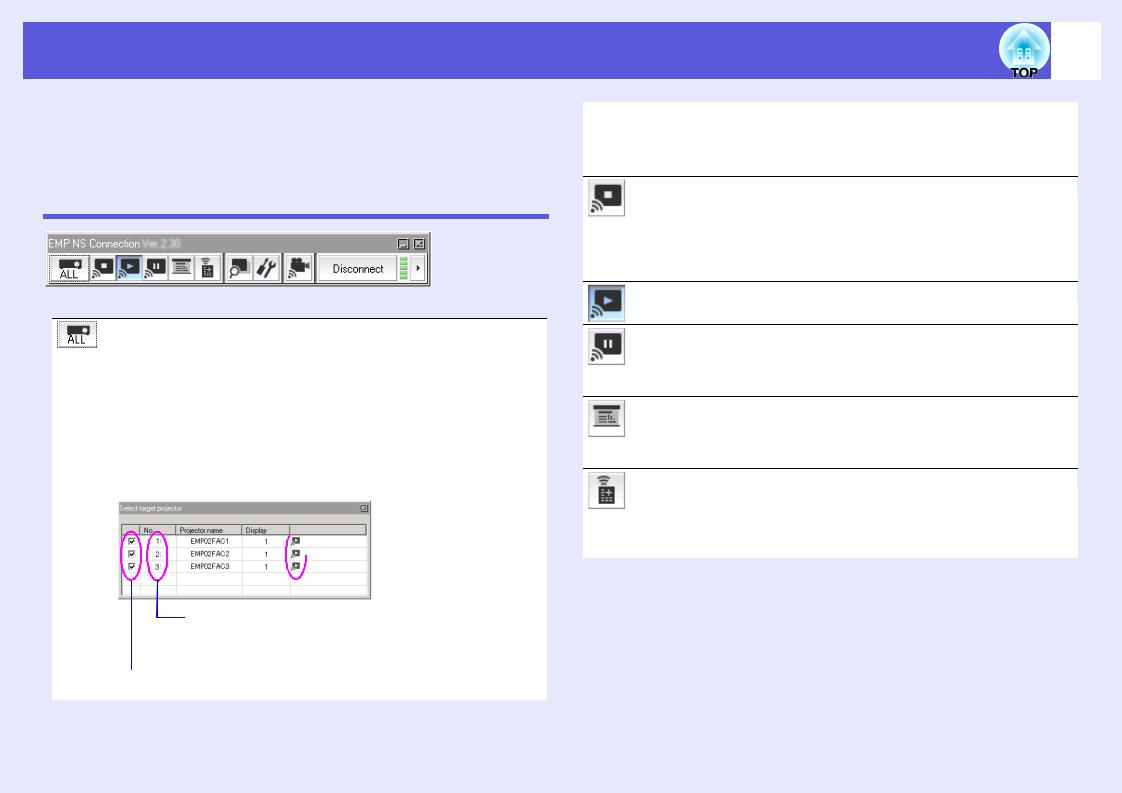
Using the Toolbar
The toolbar is displayed on the computer screen after EMP NS
Connection is started and the connection with the projector is established. This toolbar allows you to control and make settings for the projector being used.
Icon Names and Functions
Select target projector
It is possible to specify one particular projector when you want to use to the toolbar to control that projector, despite the distribution function or multi-screen display being used to project images from multiple connected projectors. The indication below the icon indicates that control of that projector is possible.
"ALL" indicates that all of the connected projectors can be controlled. For example, when "1, 3" is displayed, projectors No. 1 and No. 3 can be controlled.
Clicking  causes the following screen to be displayed.
causes the following screen to be displayed.
 Indicates the projection status of the projector.
Indicates the projection status of the projector.
Indicates the number of an assigned projector. When control of a specific projector has been set up, indicates the number of the projector that can be controlled from the toolbar.
Select the projector to be controlled.
10
Indicates the projection status of the projector.
 Stop
Stop  Show
Show  Pause
Pause
 Presentation Mode
Presentation Mode  Movie Sending Mode
Movie Sending Mode
Stop
Stops projection of computer images while connecting to the projector. While projection is stopped, a black screen is projected. While audio is being output from a projector, the audio cannot be stopped. To stop the audio, or to display a blue screen or a user-registered logo while projection is stopped, use the A/V mute function.
Show
Also, stop or pause is canceled.
Pause
Pauses projection of computer images when connected to the projector. The image at the point it was paused is projected. While audio is being output from a projector, the audio cannot be paused.
Presentation Mode
When a PowerPoint Slideshow is being presented, project only the Slideshow images. When the Slideshow is not being presented, a black screen is projected. s p.13
Projector control
While the projector is connected to the network, the unit’s "AV Mute", "Switch PC source" and "Switch video source" functions can be controlled from both the remote control and the projector’s operating panel.

Using the Toolbar
Clicking  causes the following toolbar to be displayed.
causes the following toolbar to be displayed.
Switch video source
A/V Mute |
Switch PC source |
 A/V Mute
A/V Mute
Operation using this toolbar is the same as when using the remote control. sUser's Guide "Remote Control"
Switch PC source
Each time this is clicked, the image is switched between that being received from the computer connected to the input terminal and that from the computer connected through the EMP NS Connection.
Switch video source
This switches to the image input from equipment connected to the projector’s video input or S-video input port.
Screen Preview
Displays the multi-screen preview screen.
 Screen Preview
Screen Preview
Clicking this causes a preview of the display with the settings you have made to appear. Clicking each display causes each preview window to be enlarged to full-screen.
11
Set options
Transmission performance during the transfer of computer images can be adjusted. s p.34
Movie Sending Mode
Used to immediately play back a movie file. s p.14
Disconnect
Disconnects the connection to the projector. s Wireless LAN Quick Connection Guide
Signal intensity
This is displayed when the connection is made in the "Quick Connection mode". As the signal strength increases, so does the number of lit indicators.
Switch toolbar display
The toolbar display is switched as follows. The toolbar display remains as is until next switched.
Full
Normal
Simple

Convenient EMP NS Connection Functions
This section explains those functions that may be useful during meetings or when making a presentation, such as the ability to send a movie file directly to a projector for playback ("Movie Sending Mode") or that which allows you to send images to multiple projectors from a single computer ("Multi-Screen Display").
Projecting Only a PowerPoint Slideshow |
|
(Presentation Mode) ........................................... |
13 |
Projecting Movies from a Computer |
|
(Movie Sending Mode)........................................ |
14 |
• Supported file types .......................................................... |
14 |
• Playing back a movie ........................................................ |
14 |
Using Multi-Screen Display ............................... |
16 |
• Example of Adjusting the Virtual Display ..................... |
16 |
• Procedure before using the Multi-screen Display |
|
Function............................................................................. |
17 |
• Setting the Virtual Display .............................................. |
18 |
Enable the virtual display driver (Windows only)......................... |
18 |
Virtual display arrangement........................................................... |
18 |
• Allocating the image to be projected .............................. |
23 |
• The allocated image is projected..................................... |
23 |

Projecting Only a PowerPoint Slideshow (Presentation Mode) |
13 |
|
|
In Presentation Mode, only when performing a PowerPoint Slideshow on a computer, the images are displayed. This is useful when you only want to display the Slideshow.
In addition to PowerPoint, Keynote is compatible with Presentation
Mode with the Macintosh.
Procedure
A If necessary, select another projector to be controlled.s p.10
B Click the  button on the toolbar.
button on the toolbar.
Presentation Mode begins.
C When in Presentation Mode, click the |
|
button |
|
||
again to exit Presentation Mode. |
|
|
|
|
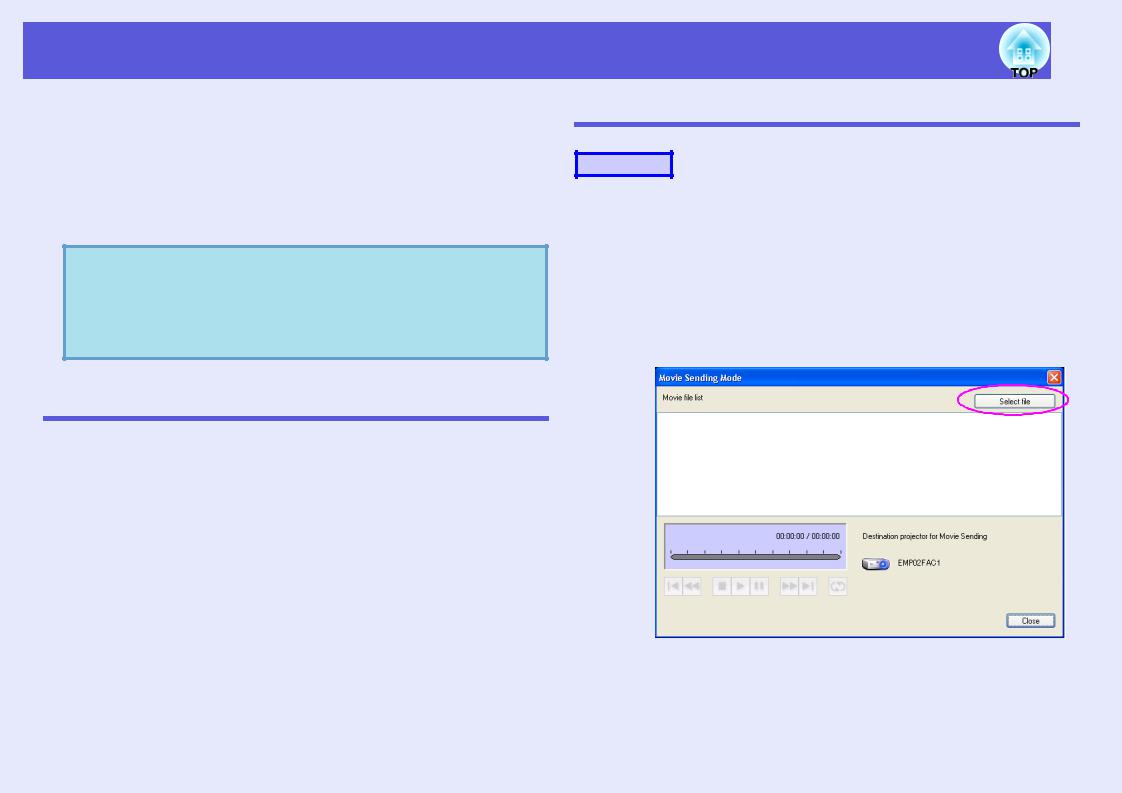
Projecting Movies from a Computer (Movie Sending Mode) |
14 |
|
|
In Movie Sending Mode, movie files can be sent directly to a projector.
As a result, a movie can be projected much more smoother than when it is being sent from an application running on a PC.
Also, because the audio is sent at the same time as the video, there is no need for an audio cable between the computer and the projector. When you select multiple files, they are played back repeatedly and in sequence.
• Movie Sending Mode is valid for one projector only. It is q not possible to apply Movie Sending Mode to more than
one projector.
•Depending on the communication method and the available reception, the image and sound may skip or stall.
Supported file types
The file types supported by Movie Sending Mode are listed in the following table.
File type |
Notes |
|
(extension) |
||
|
||
.mpg |
MPEG2 |
|
|
The reproducible audio format is MPEG1 Layer 1/ |
|
|
2. Linear PCM and AC-3 audio cannot be played |
|
|
back. MPEG contents with no sound can be played |
|
|
back. |
|
|
|
Files to which DRM (Digital Rights Management) is applied cannot be projected.
Playing back a movie
Procedure
A Click the  button on the toolbar.
button on the toolbar.
The projector selection screen is displayed.
B Select the destination projector for Movie Sending and click the "OK" button.
The "Movie Sending Mode" screen appears.
C Click the "Select file" button.
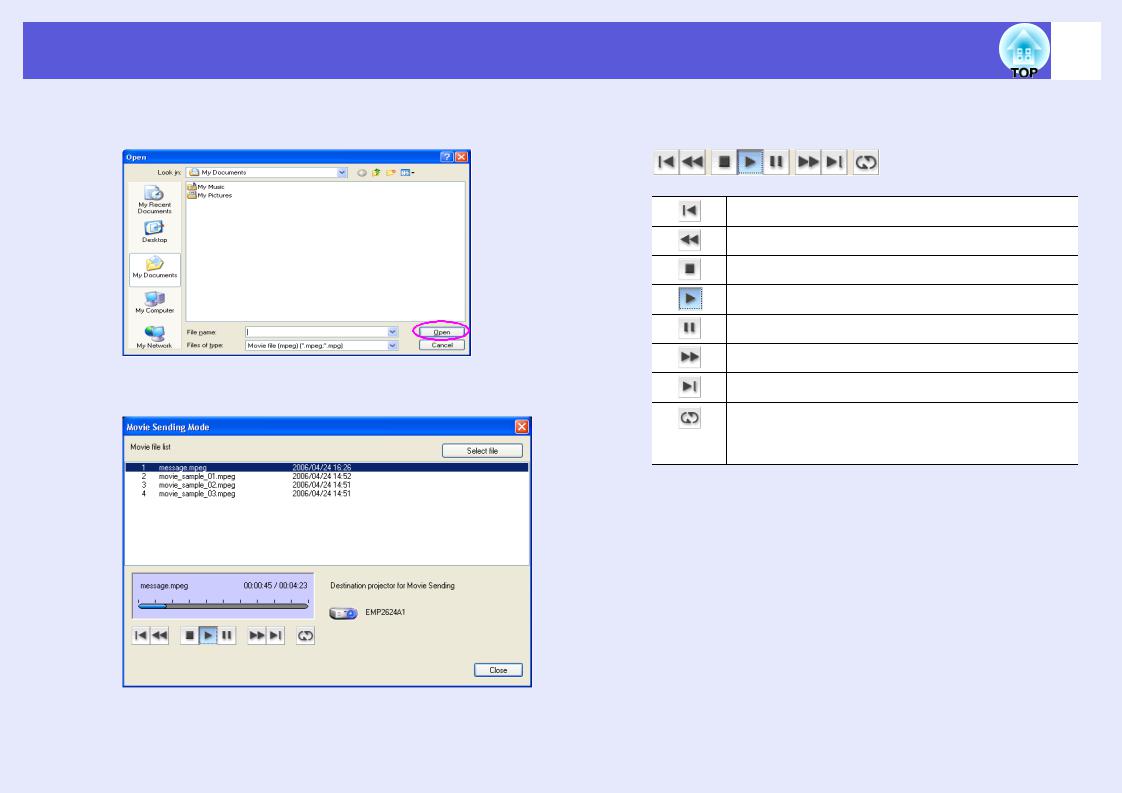
Projecting Movies from a Computer (Movie Sending Mode)
D Select the movie file you want to play back and then click the "Open" button.
The "Movie Sending Mode" screen reappears. The file you selected is added to the movie file list.
15
E Use the operation buttons below to play and stop the movie files.
Plays back from the beginning of the file that is playing.
Quickly rewinds the file that is playing.
Stops play back.
Plays back the file.
Pauses play back.
Quickly fast-forwards the file that is playing.
Plays back from the beginning of the next file.
Repeatedly plays back the file list in order. When there are multiple files in the list, it is not possible to repeatedly play back only some of those files.
F ClickMode.the "Close" button to end Movie Sending
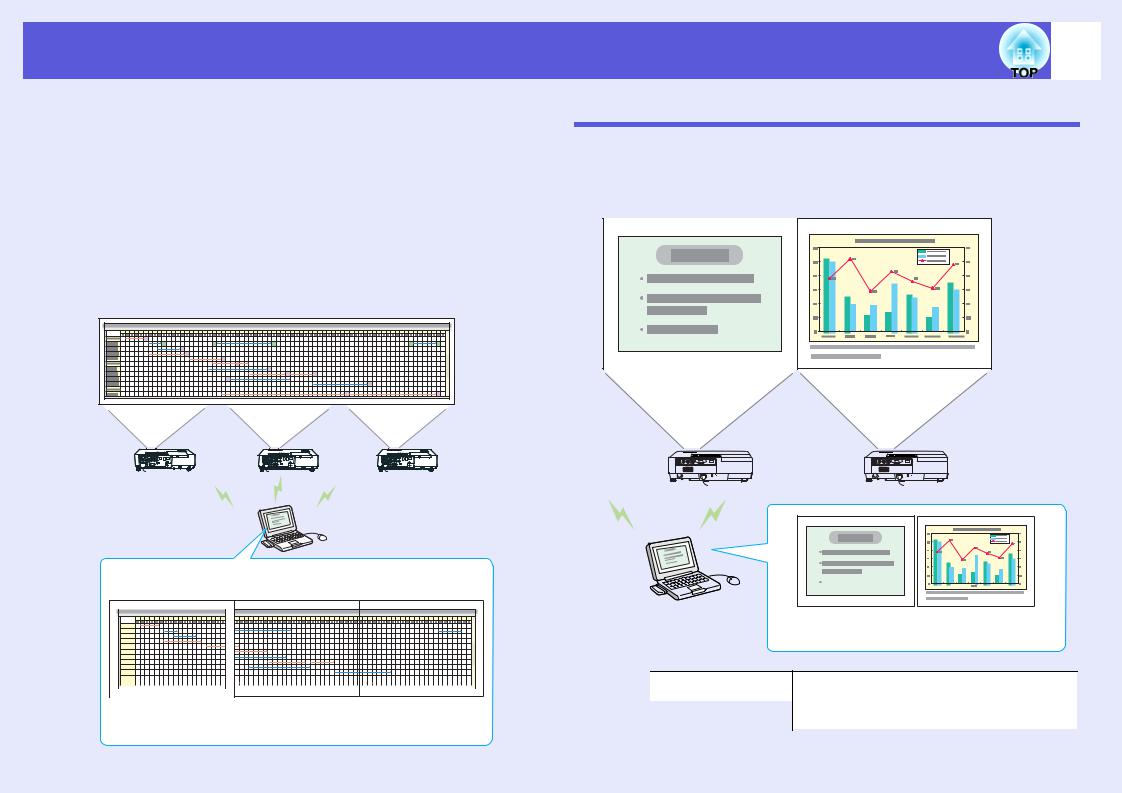
Using Multi-Screen Display
Multi-screen display mode allows you to project different images from multiple projectors that are connected to a single computer.
With Windows, multiple virtual displays can be set in the computer, and each image can be projected by the projector. This function is not available with Windows Vista due to restrictions in the Windows Vista specifications.
For the Macintosh, an external monitor must be connected to the computer to enable the use of the multi-screen display function. Whereas the above explanation has referred to "virtual display", in the case of the Macintosh, the operation relates to the screens displayed on the physically connected monitor.
16
Example of Adjusting the Virtual Display
By arranging the virtual display allocation, you can project only the image that you want to show when making a presentation or project different images from left to right.
Arrangement example 1
Virtual display
|
|
|
|
|
|
|
|
|
|
|
|
|
|
|
|
|
|
|
|
|
|
|
|
|
|
|
|
|
|
|
|
|
|
|
|
|
|
|
|
|
|
|
|
|
|
|
|
|
|
|
|
|
|
|
|
|
|
|
|
|
|
|
|
|
|
|
|
|
|
|
|
|
|
|
|
|
|
Actual monitor |
Image of virtual |
||||||||||||||
|
|
|
|
|
|
|
|
|
|
|
|
|
|
|
|
|
|
|
|
|
|
|
|
|
|
|
|
|
|
|
||||||||||||||||
|
|
|
|
|
|
|
|
|
|
|
|
|
|
|
|
|
|
|
|
|
|
|
|
|
|
|
|
|
|
|
||||||||||||||||
|
|
|
|
|
|
|
|
|
|
|
|
|
|
|
|
|
|
|
|
|
|
|
|
|
|
|
|
|
|
|
|
image |
|
|
|
|
display |
|||||||||
|
|
|
|
|
|
|
|
|
|
|
|
|
|
|
|
|
|
|
|
|
|
|
|
|
|
|
|
|
||||||||||||||||||
|
|
|
|
|
|
|
|
|
|
|
|
|
|
|
|
Actual monitor |
PowerPoint file |
|
|
|
|
|
|
|
|
|
|
|
|
|
|
|
|||
|
|
|
|
|
|
|
|
|
|
|
|
|
|
|
|||
|
|
|
Actual monitor |
|
Image of virtual |
|
Image of virtual |
|
|
|
|
|
|||||
|
|
|
|
|
|
|
|
Virtual display |
Excel file |
||||||||
|
|
|
|
|
image |
|
display 1 |
|
display 2 |
|
|
|
|
|
|||
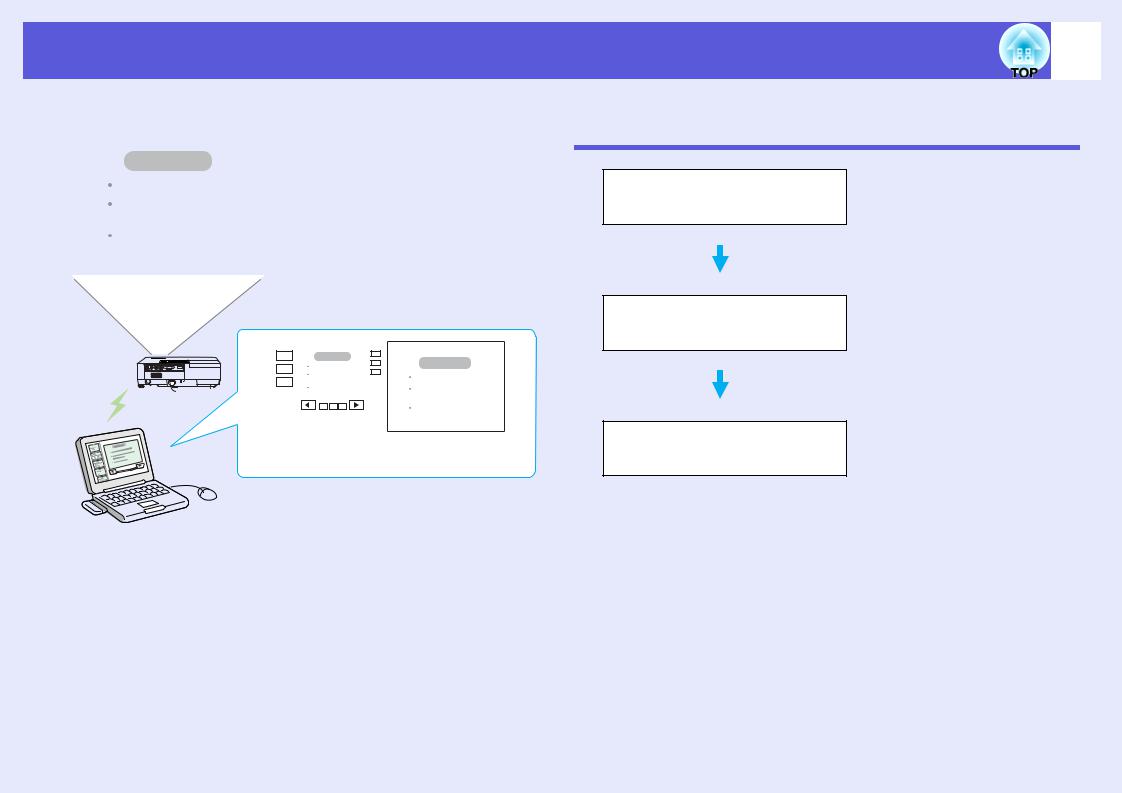
Using Multi-Screen Display
Arrangement example 2
|
|
|
|
|
|
|
|
|
|
|
|
|
|
|
|
|
|
|
|
|
|
|
|
|
|
|
|
|
|
|
|
|
|
|
|
|
|
|
|
|
|
|
|
|
|
|
|
|
|
|
|
|
|
|
|
|
|
|
|
|
|
|
|
|
|
|
|
|
|
|
|
|
|
|
|
|
|
|
|
|
|
|
|
|
|
|
|
|
|
|
|
|
|
|
|
|
|
|
|
|
|
|
|
|
|
|
|
|
|
|
|
|
|
|
|
|
|
|
|
|
|
|
|
|
|
|
|
|
|
|
|
|
|
|
|
|
|
|
|
|
|
|
|
|
|
|
|
|
|
|
|
|
|
|
|
|
|
|
|
|
|
|
|
|
|
|
|
|
|
|
|
|
|
|
|
|
|
|
|
|
|
|
|
|
|
|
|
|
|
|
|
|
|
|
|
|
|
|
|
|
|
|
|
|
|
|
|
|
|
|
|
|
|
|
|
|
|
|
|
|
|
|
|
|
|
|
|
|
|
|
|
|
|
|
|
|
|
|
|
|
|
|
|
|
|
|
|
|
|
|
|
|
|
|
|
|
|
|
|
|
|
|
|
|
|
|
|
|
|
|
|
|
|
|
|
|
|
|
|
|
|
|
|
|
|
|
|
|
|
|
|
|
|
|
|
|
|
|
|
|
|
|
|
|
|
|
|
|
|
|
|
|
|
|
|
|
|
|
|
|
|
|
|
|
|
|
|
|
|
|
|
|
|
|
|
|
|
|
|
|
|
|
|
|
|
|
|
|
|
|
|
|
|
|
|
|
|
|
|
|
|
|
|
|
|
|
|
|
|
|
|
|
|
|
|
|
|
|
|
|
|
|
|
|
|
|
|
|
|
|
|
|
|
|
|
|
|
|
|
|
|
|
|
|
|
|
|
|
|
|
|
|
|
|
|
|
|
|
|
|
|
|
|
|
|
|
|
|
|
|
|
|
|
|
|
|
|
|
|
|
|
|
|
|
|
|
|
|
|
|
|
|
|
|
|
|
|
|
|
|
|
|
|
|
|
|
|
|
|
|
|
|
|
|
|
|
|
|
|
|
|
|
|
|
|
|
|
|
|
|
|
|
|
|
|
|
|
|
|
|
|
|
|
|
|
|
|
|
|
|
|
|
|
|
|
|
|
|
|
|
|
|
|
|
|
|
|
|
|
|
|
|
|
|
|
|
|
|
|
|
|
|
|
|
|
|
|
|
|
|
|
|
|
|
|
|
|
|
|
|
|
|
|
|
|
|
|
|
|
|
|
|
|
|
|
|
|
|
|
|
|
|
|
|
|
|
|
|
|
|
|
|
|
|
|
|
|
|
|
|
|
|
|
|
|
|
|
|
|
|
|
|
|
|
|
|
|
|
|
|
|
|
|
|
|
|
|
|
|
|
|
|
|
|
|
|
|
|
|
|
|
|
|
|
|
|
|
|
|
|
|
|
|
|
|
|
|
|
|
|
|
|
|
|
|
|
|
|
|
|
|
|
|
|
|
|
|
|
|
|
|
|
|
|
|
|
|
|
|
|
|
|
|
|
|
|
|
|
|
|
|
|
|
|
|
|
|
|
|
|
|
|
|
|
|
|
|
|
|
|
|
|
|
|
|
|
|
|
|
|
|
|
|
|
|
|
|
|
|
|
|
|
|
|
|
|
|
|
|
|
|
|
|
|
|
|
|
|
|
|
|
|
|
|
|
|
|
|
|
|
|
|
|
|
|
|
|
|
|
|
|
|
|
|
|
|
|
|
|
|
|
|
|
|
|
|
|
|
|
|
|
|
|
|
|
|
|
|
|
|
|
|
|
|
|
|
|
|
|
|
|
|
|
|
|
|
|
|
|
|
|
|
|
|
|
|
|
|
|
|
|
|
|
|
|
|
|
|
|
|
|
|
|
|
|
|
|
|
|
|
|
|
|
|
|
|
|
|
|
|
|
|
|
|
|
|
|
|
|
|
|
|
|
|
|
|
|
|
|
|
|
|
|
|
|
|
|
|
|
|
|
|
|
|
|
|
|
|
|
|
|
|
|
|
|
|
|
|
|
|
|
|
|
|
|
|
|
|
|
|
|
|
|
|
|
|
|
|
|
|
|
|
|
|
|
|
|
|
|
|
|
|
|
|
|
|
|
|
|
|
|
|
|
|
|
|
|
|
|
|
|
|
|
|
|
|
|
|
|
|
|
|
|
|
|
|
|
|
|
|
|
|
|
|
|
|
|
|
|
|
|
|
|
|
|
|
|
|
|
|
|
|
|
|
|
|
|
|
|
|
|
|
|
|
|
|
|
|
|
|
|
|
|
|
|
|
|
|
|
|
|
|
|
|
|
|
|
|
|
|
|
|
|
|
|
|
|
|
|
|
|
|
|
|
|
Actual monitor |
|
Image of virtual |
|||||||||||||||||||||||
|
|
|
|
|
|
|
|
|
|
|
|
|
|
|
image |
|
|
display |
||||||||||||||||||||
17
Procedure before using the Multi-screen Display Function
1.Adjusting the Virtual Display s p.18
2.Allocating the image to be projected s p.23
3.The allocated image is projected s p.23
In a Windows environment, enable the virtual display driver as necessary. And, for both Windows and the Macintosh, set up the virtual display arrangement.
Open the file to be projected, and then move the screen to the virtual display according to the actual projection arrangement.
Allocate a virtual display number to a projector that is connected through the network, and then start projection.
Actual monitor |
PowerPoint file presenter tools |
|
|
Virtual display |
Slideshow using a PowerPoint file |
|
|
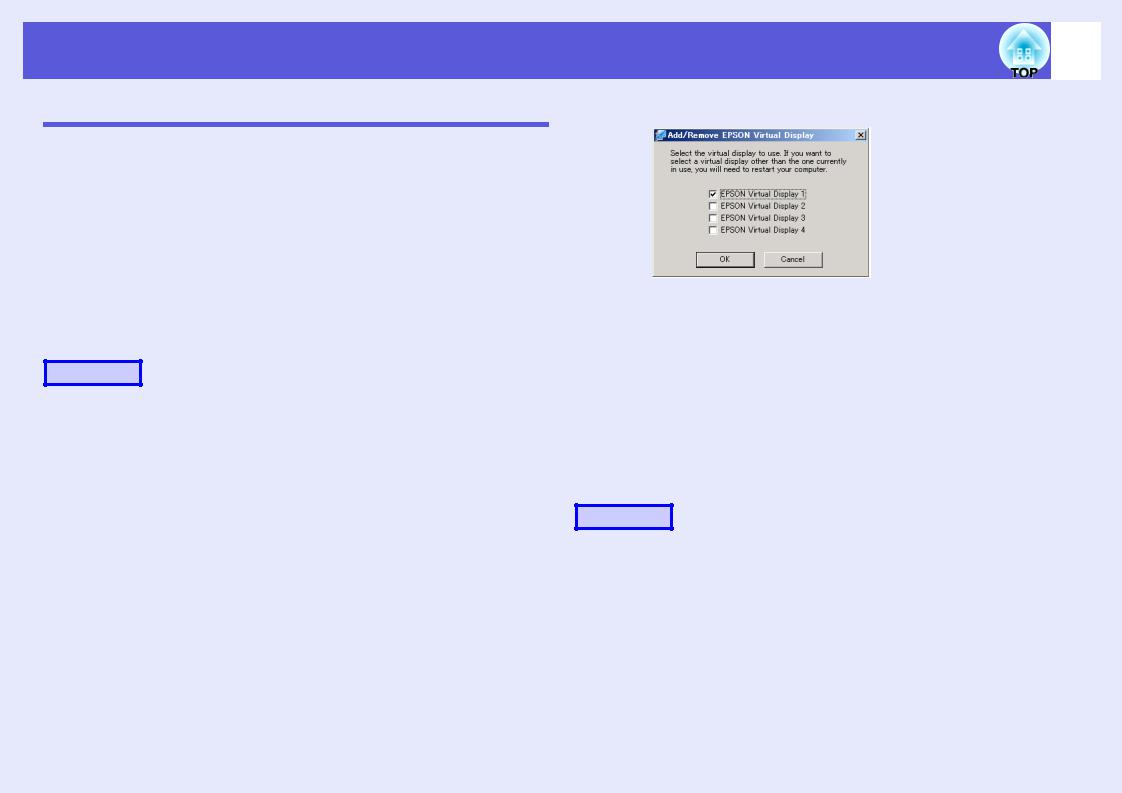
Using Multi-Screen Display
Setting the Virtual Display
The following explains how to allocate the computer image using arrangement example 1 on page 16.
fEnable the virtual display driver (Windows only)
Enable the virtual display driver. Those users listed below do not have to perform this operation. Perform the "Virtual display arrangement" (Windows), or "Virtual display arrangement" (Macintosh). s p.18
•Those users who have enabled virtual displays installing EMP NS Connection.
•Those users who are using Macintosh computers.
Procedure
A Start Windows on the computer, then select "Start" -
"Programs" (or "All Programs") - "EPSON Projector" - "Add/Remove Epson Virtual Display".
The "Add/Remove EPSON Virtual Display" screen is displayed. Place a check mark against the virtual display to be used.
Up to four monitors can be added. In this case, a single virtual display is to be used, so select one. When, for example, using three projectors, such that you have to set multiple virtual displays, only select as many displays as is necessary.
Any one of the displays can be selected.
18
B Click the "OK" button.
When you click "OK", the drivers for the virtual display are enabled. At this point, it is normal for the display to flicker. Wait for the "Add/Remove Epson Virtual Display" screen to close.
fVirtual display arrangement
After starting EMP NS Connection, the setting up of the virtual displays varies between Windows and the Macintosh. The procedures are explained separately, below.
For Windows, follow the procedure below. For the Macintosh, go to s p.21.
Procedure
For Windows
A To start EMP NS Connection, select "Start" -
"Programs" (or "All Programs") - "EPSON Projector" - "EMP NS Connection".
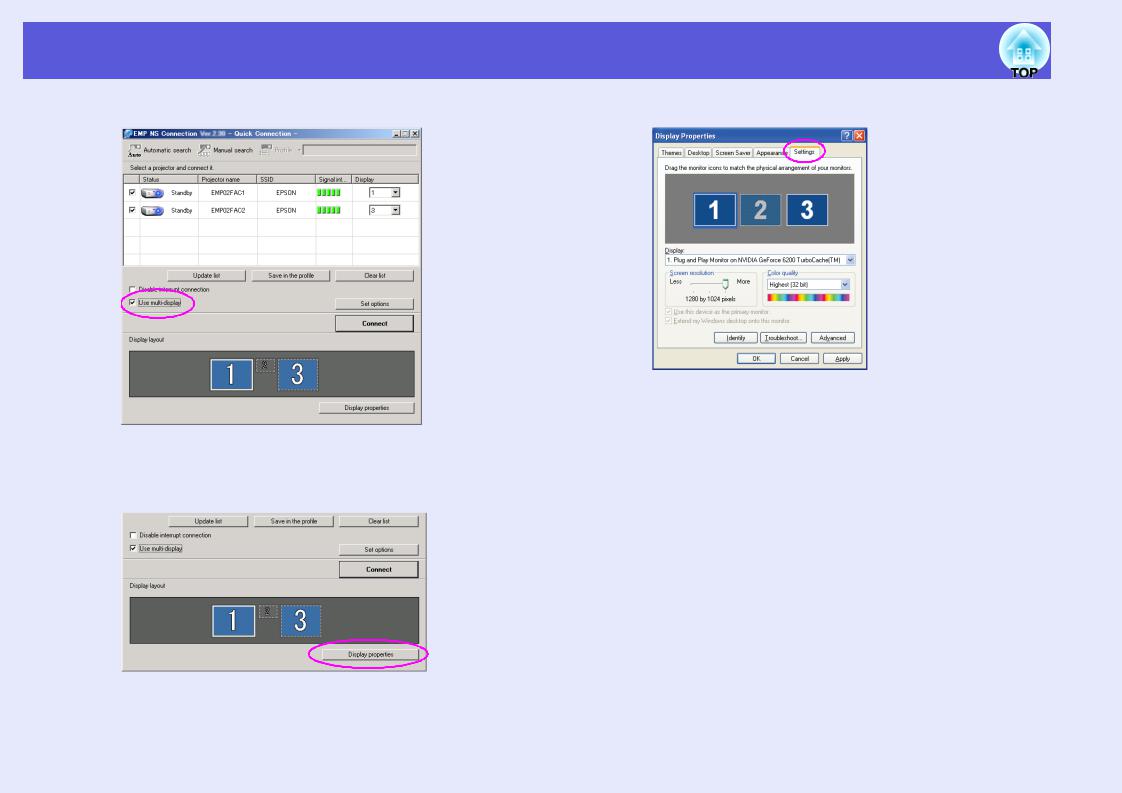
Using Multi-Screen Display |
19 |
|
|
B Select the "Use multi-display" check box. |
D Click the "Settings" tab. |
"Display layout" and "Display properties" buttons are added at the bottom of the screen.
C Click the "Display properties" button.
The "Display Properties" screen will be displayed.
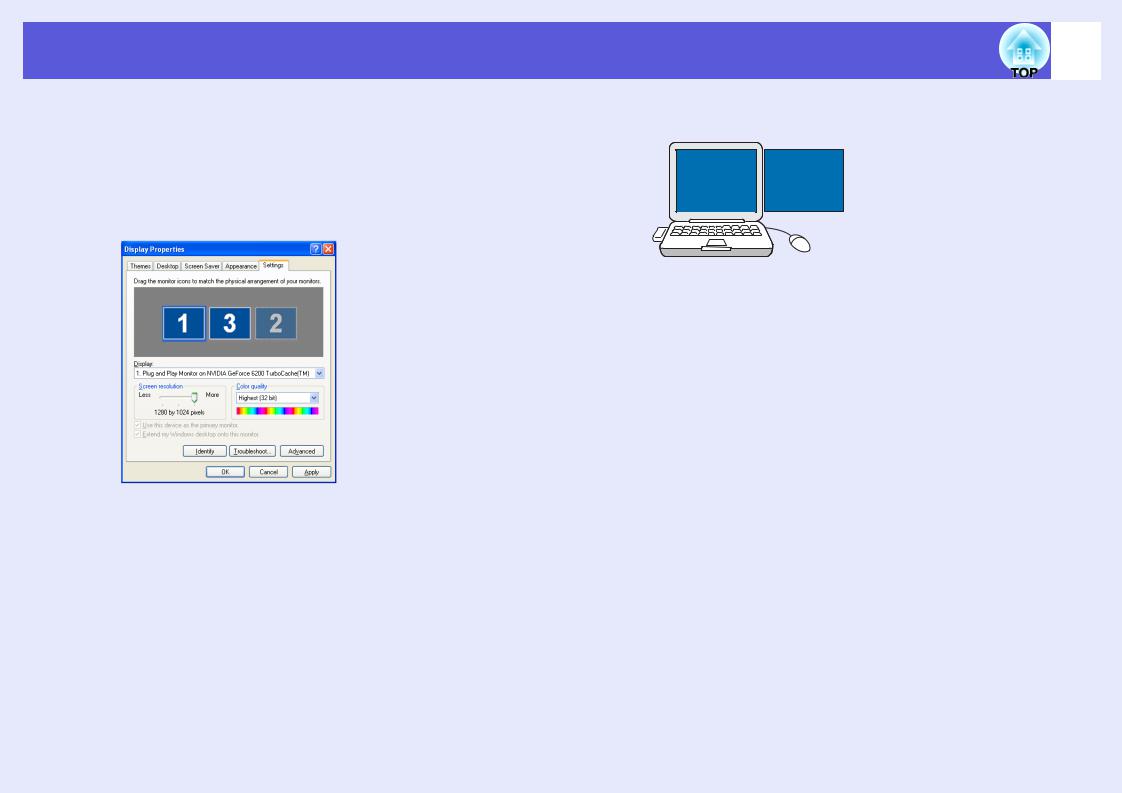
Using Multi-Screen Display
E Dragdesired.the displayed monitor icon and place it where
Here, the actual monitor (1) is placed on the left, while the virtual monitor (3) is placed on the right.
When the PC has multiple display output terminals, the numbers assigned to the virtual terminals will be sequential to those of the physical terminals.
20
When the monitor icon appears as follows, a virtual display is connected.
1 |
3 |
F Click the "OK" button. The "Display Properties" screen closes.
Up to this point, the virtual display layout has been fixed. Go to s p.23.
q |
• When an external monitor is connected as a secondary |
monitor, the image for that screen cannot be projected. |
|
|
• Depending on the hardware, the number of the secondary |
|
monitor may be other than "2". When the monitor icon is |
|
displayed on the screen, click the icon and confirm that |
|
the monitor type shown under "Display" is other than |
|
"secondary". |
|
|
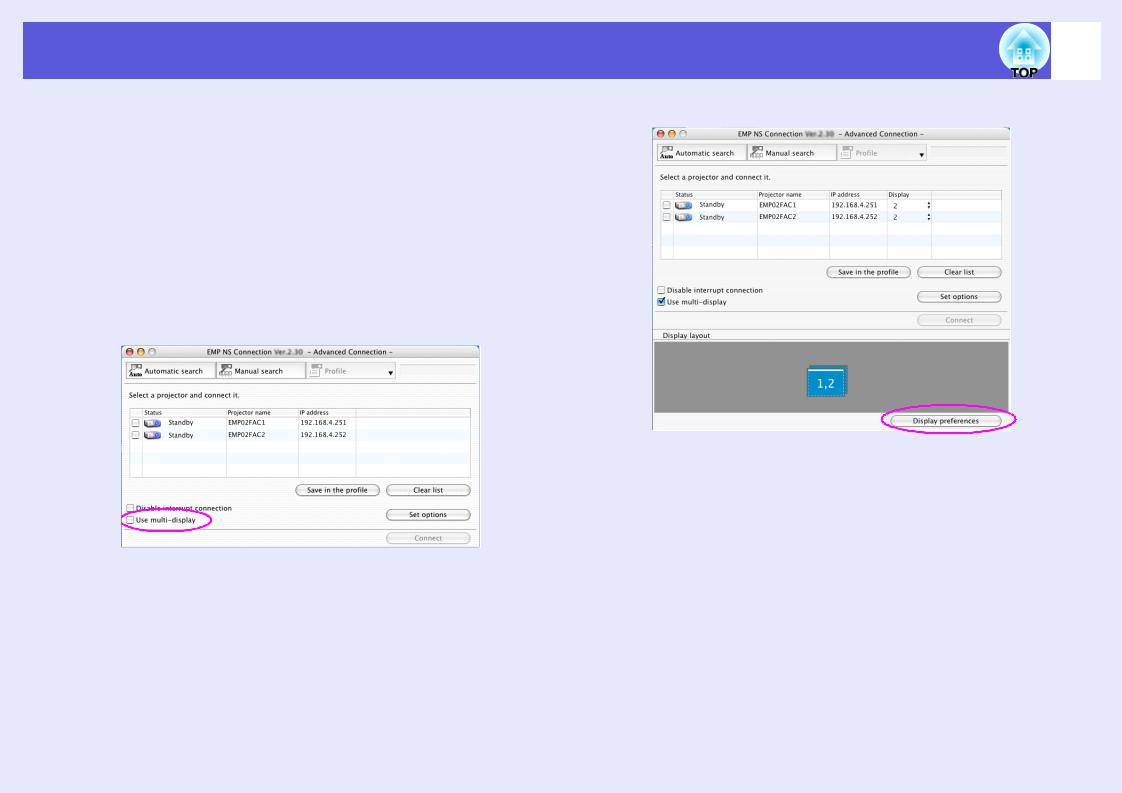
Using Multi-Screen Display
For Macintosh
A Start EMP NS Connection. Double-click the
"Applications" folder of the hard drive volume in which EMP NS Connection is installed, and then double-click the EMP NS Connection icon. EMP NS Connection starts.
Select "Advanced Connection Mode" and then perform startup. The "Advanced Connection Mode" screen is displayed.
B Select the "Use multi-display" check box.
"Display layout" and "Display preferences" buttons are added at the bottom of the screen.
21
C Click the "Display preferences" button.
The display setting screen is displayed.
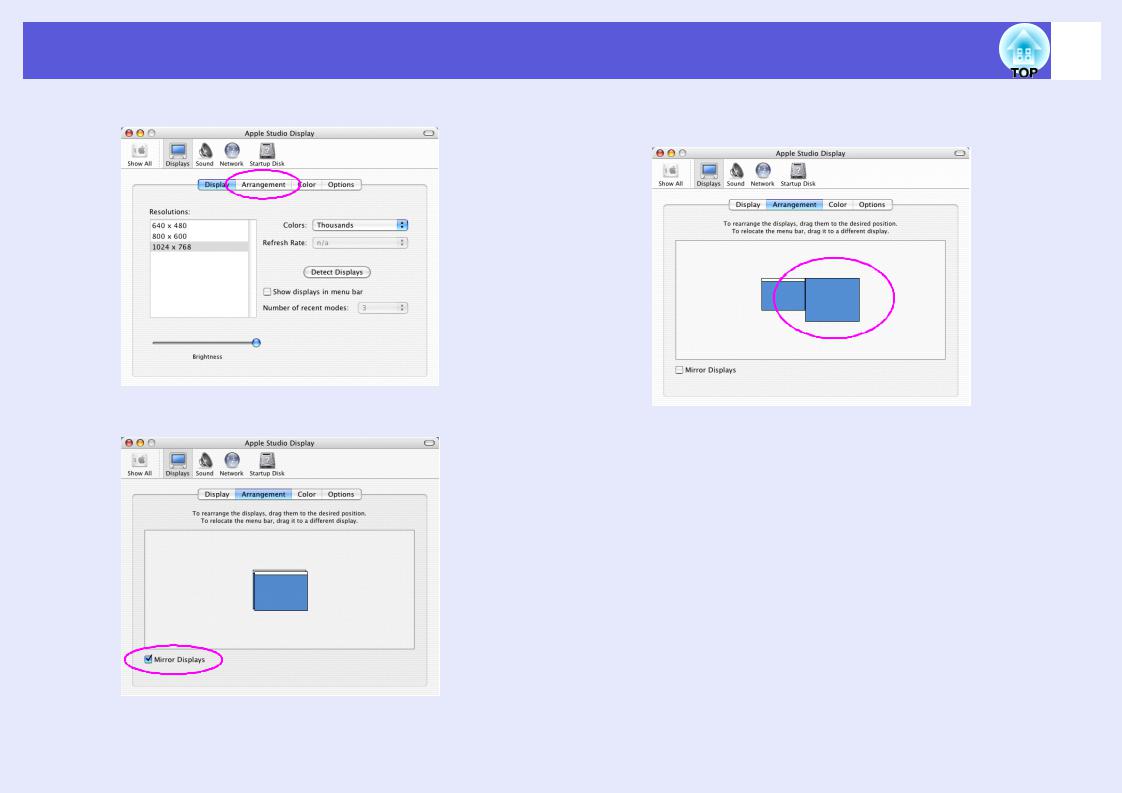
Using Multi-Screen Display
D Click the "Arrangement" button.
E Deselect Mirror Displays.
22
F Dragdesired.the displayed monitor icon and place it where
G Close the display setting screen.
Up to this point, the screen layout has been fixed. Go to s p.23.
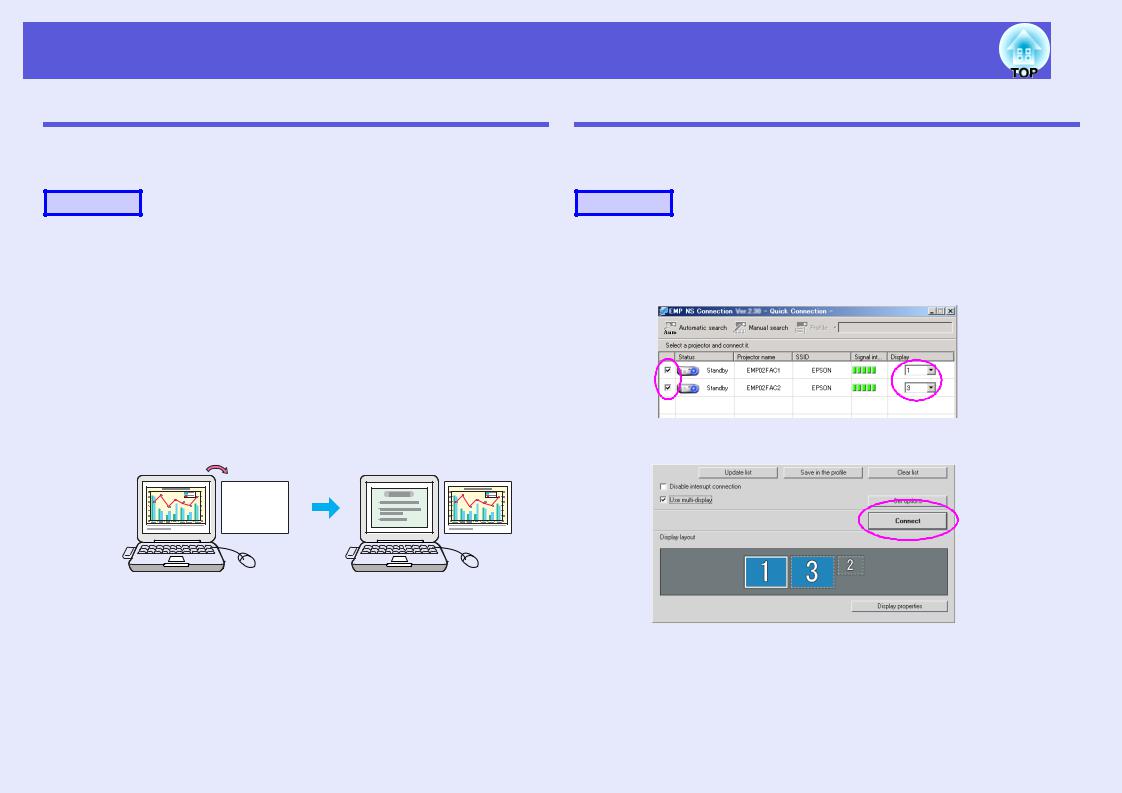
Using Multi-Screen Display |
23 |
|
|
Allocating the image to be projected
The following explains how to allocate the computer image using arrangement example 1 on page 16.
Procedure
A Open the file to be projected.
For arrangement example 1 on page 16, open the PowerPoint file and Excel file.
B Drag the window to the desired virtual display monitor, and allocate it where the image is to be projected.
In the example in which the PowerPoint and Excel files are opened, drag the Excel window to the right until it can no longer be seen. As a result, the PowerPoint window appears on the actual monitor, while the Excel window appears on the virtual display on the right.
The allocated image is projected
The following explains how to allocate the computer image using arrangement example 1 on page 16.
Procedure
A Select the number of the virtual display to allocate to "Display", and set which image to be projected from which projector.
B Click the "Connect" button.

Using Multi-Screen Display
The image allocated to each projector is projected.
In a Windows environment, you cannot view the image being sent to a virtual display on the computer. To adjust the image on the virtual display, you must do so while viewing the projected image. To perform mouse-based operations on the virtual display, move the mouse pointer in the direction of the virtual display, such that the pointer appears on the virtual display.
24
C To terminate multi-screen display, click
"Disconnect" on the toolbar.
• In a Windows environment, if the virtual display driver has q been enabled such that the mouse pointer can be moved
outside the limits of the screen, there may be occasions when you lose track of the location of the pointer. When you are not using a virtual display, clear the check mark against the under "Add/Remove EPSON Virtual Display", such that the mouse pointer cannot be moved outside the limits of the screen. To subsequently use multi-screen display again, again place a check mark against the required display under "Add/Remove EPSON Virtual Display".
To clear a check mark, see the following.s p.18
•You can adjust each projector’s color tone.
sUser's Guide "Adjusting Colour for Several Projectors
(Multi-Screen Colour Adjustment)"

Connecting to a projector on a different sub-net
This chapter explains how to connect a computer to a projector on a different sub-net via a wired LAN or a wireless LAN access point on an existing network system.
Connecting to a projector on a different |
|
sub-net................................................................. |
26 |
Searching by Specifying the IP Address and |
|
Projector Name (For "Advanced Connection |
|
Mode" only) ......................................................... |
27 |
Performing a search with a profile.................... |
28 |
• Making a Profile................................................................ |
28 |
• Searching by Specifying a Profile .................................... |
30 |
• Managing a Profile............................................................ |
31 |

Connecting to a projector on a different sub-net |
26 |
|
|
By default, this application only searches for projectors on the same sub-net as the computer. Therefore, even if you perform a search for projectors on the network, one on a different sub-net will not be found.
You can, however, identify and connect to a projector on a different sub-net, as follows.
•Specify either an IP address or projector name and perform a search.
The IP address can be input directly. Also, provided the name of the connected server has been registered on the DNS server, you perform a search simply by inputting that name.s p.27
•Performing a search based on a profile
Once you have performed a search for a projector on a different subnet by specifying either an IP address or a projector name, you can save the search as a profile with an easy-to-remember name, and then use that profile whenever you subsequently want to search for a projector on a different sub-net.s p.28
If a search fails to find a projector, the most likely causes q are as follows. Proceed as appropriate, depending on the
cause of the failure.
For both Windows and the Macintosh
•The wireless LAN signal is either out of range or weak. Check whether there is anything that could be interfering with the signal.
For the Macintosh
•"AirPort: On" is not set, or an appropriate access point is not selected.
Check whether AirPort is set to "On". Or, check whether an appropriate access has been selected.
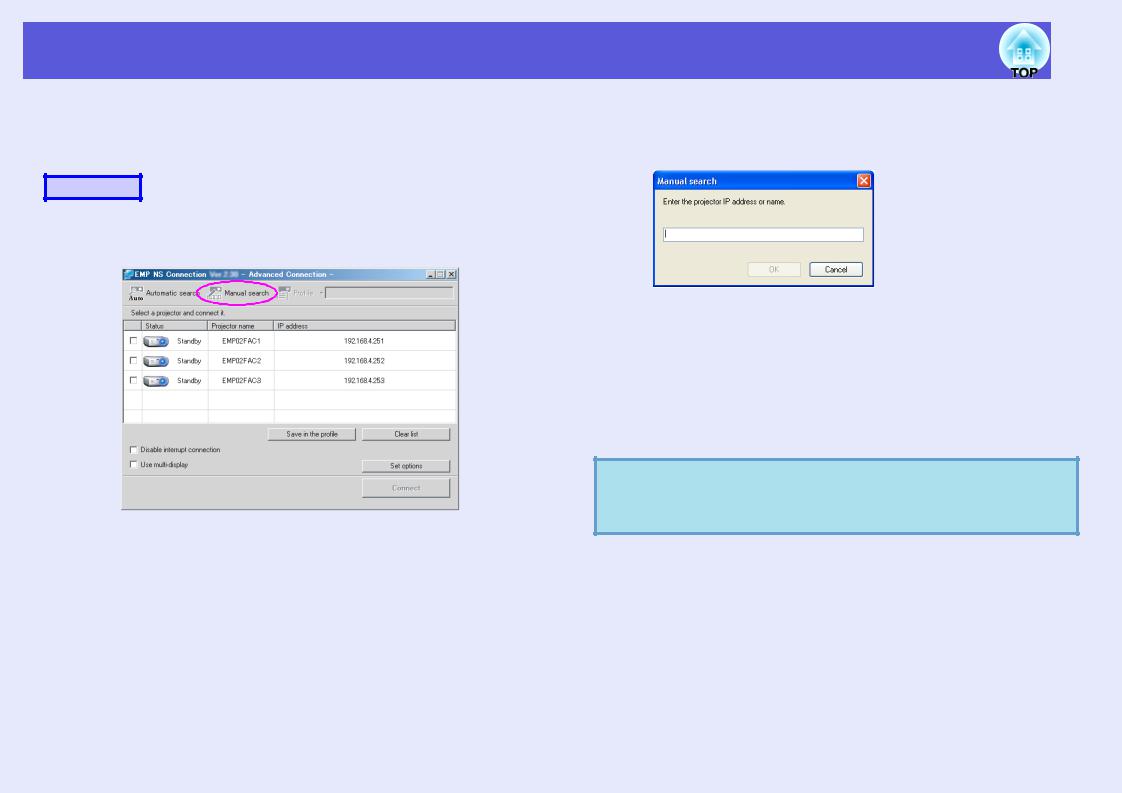
Searching by Specifying the IP Address and Projector Name (For "Advanced Connection Mode" only) |
27 |
|
|
In the following explanations, unless otherwise noted, Windows screen shots are used.
You see a similar screen even when using Macintosh.
B Enter the IP address or the projector name for the projector you want to connect to, and click the "OK" button.
Procedure
A Click "Manual search" on the EMP NS Connection projector selection screen.
The results of the search are shown on the EMP NS Connection projector selection screen.
Assuming that the desired projector has been found by the search, select that projector and then click the "Connect" button to establish a connection.
When you will always be using that projector, save the search as a profile, such that you do not have to specify the relevant details every time you perform a search.s p.28
When you use "Manual search" in "Quick Connection q Mode", you can specify the SSID. When there are a lot of
projectors you can narrow the search field by using SSID.
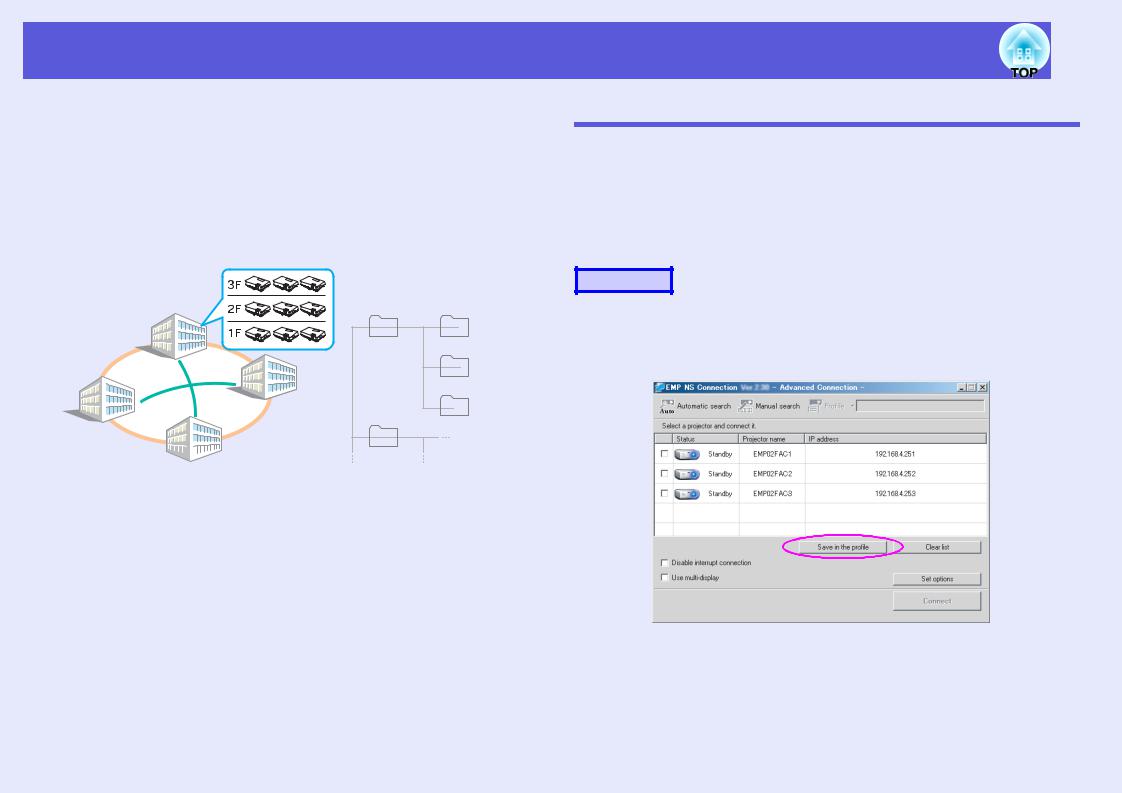
Performing a search with a profile |
28 |
|
|
You can save a search for a frequently used projector as a profile. A
"profile" is a file containing all of the information pertaining to a given projector, such as the projector name, its IP address, and SSID. By specifying that profile whenever you subsequently perform a search, the search will be performed using the saved IP address and projector name. For example, by creating a group of profiles for each place where a projector is setup and managing them with folders, the target projector can be found quickly.
Location A |
Location A Floor 1 |
Floor 2
Location B
Floor 3
Location D
Location B
 Location C
Location C
This section explains how to create and edit a profile.
Making a Profile
Profiles are made by saving searched results.
For details on how to edit a previously saved profile, see "Managing a Profile". s p.31
For details on how to locate a projector on a different sub-net, see "Searching by Specifying the IP Address and Projector Name (For "Advanced Connection Mode" only)". s p.27
Procedure
A When the projector is displayed on the EMP NS
Connection projector selection screen, click the "Save in the profile" button.
The "Save in the profile" screen is displayed.

Performing a search with a profile
B Enterbutton.a profile name and then click the "Add"
Projector information is registered in the profile
If you have previously saved a profile, you are prompted to confirm whether that profile can be overwritten. To save a profile with a different name, select "Save as". If you have created a folder for a profile, the following screens are displayed. After entering the profile name and selecting the save destination, click the "Add" button.
For Windows
29
For Macintosh
q For details on how to create a folder for a profile, see "Managing a Profile".s p.31

Performing a search with a profile
Searching by Specifying a Profile
You can search by specifying the profile you created.
Procedure
A Click "Profile" on the EMP NS Connection projector selection screen.
If no profile is registered, you cannot select "Profile".
30
B From the menu that is displayed, select the projector you want to connect to.
The search results are displayed on the EMP NS Connection projector selection screen.
Provided the target projector has been identified, select that projector, and then click "Connect" to establish a connection.
